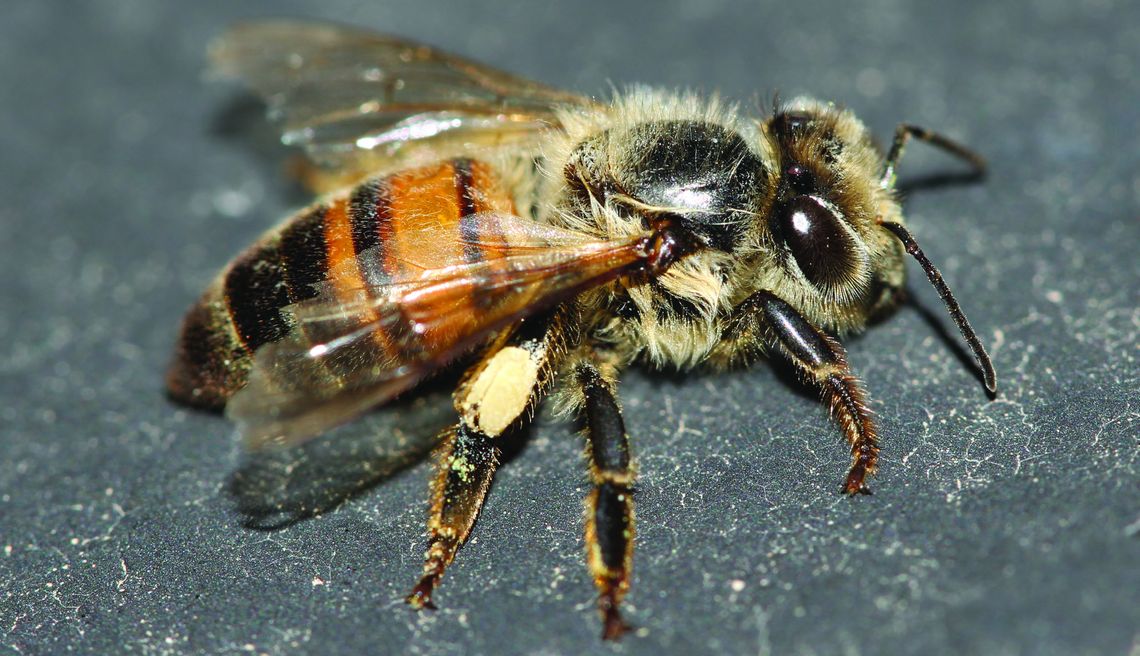The European (Western) Honey Bee (Apis mellifera) is a species that can be encountered almost worldwide, with the exception being the Antarctic region. In Texas, this honeybee occurs statewide, regardless of the myriad of climates and habitats that this state offers. This species was introduced to America by European settlers around 1638.
Just as with other insects such as grasshoppers, ants, and butterflies, honeybees have three pairs of legs, as well as three body parts. The front body part is the head, and this is where the eyes, mandibles, and antennae are. This bee has two large eyes that are surrounded by three smaller ones. The antennae are used primarily to pick up smells and air movements. The second body part is the thorax, and it is in this region where the wings and legs are attached. The last body part is the abdomen, and it is in this area where the majority of the “inner-workings” of the bee occur. It is also the area that supports the bee’s defensive stinger and venom sac. Once a bee has used this stinger, the bee will then die as it loses part of its abdomen contents in the process. The bee’s body is covered with hair, and this is one of the characteristics that separate them from the closely related wasps. They are usually around one-half inch in total length.
The honeybee lives its life in a large family group in a beehive. Each beehive can have upwards of fifty-thousand individual bees. There are four types of bees in this family group, and each has a special job unique from the other types. The largest type of bee is the Queen Bee. Each hive can have only one queen. Her job is to lay eggs, and what a job of this she does. A queen can lay up to three thousand eggs each day!
The second type of bee is the drones. These drones are the males (or fathers) of the hive. Their primary duty is to reproduce. There may be only a few hundred drones in each hive. The third type of bee is the worker bee. These are the backbone of the hive as they have more job responsibilities than the other types. They are all female, and they feed the babies (as well as the queen), they guard the nest, and they find nectar and pollen. Worker bees have pollen baskets on their legs that they utilize to carry the pollen from flowers back to the hive.
The last type of bee is the larvae. These larvae begin their life as a tiny egg laid in a cell made of wax. When they hatch, they look like small grubs and this is the part of the life cycle when they are known as larvae (plural for larva). As the larvae eat the food provided by the worker bees, they grow larger and become a pupa. The last step of this metamorphosis is when the adult bee crawls out of the pupa.
The primary diet of the honeybee is sugary nectar and powdery pollen, both which are collected by the worker bees as they visit flowers. Individual bees may visit fifty or more flowers in one trip to and from the hive. This spreads pollen from one flower to another, assisting the flowers to make more seeds and fruits. A worker bee detects a flower and lands on it. It then collects nectar inside of the flower by sucking it up with its tongue as it combs the pollen into the pollen baskets on its legs and flies away either to the next flower or back to the hive.
Worker bees use two special dance routines to alert other bees where nectar is located. The first, known as the “round dance” is performed when the food is within one hundred and ten yards from the hive. The second is known as the “waggle dance”, and this performance is utilized to communicate that the food is farther away. These dances can tell the other workers not only how far to go, but also which direction the food is.
Honey is utilized not only by the bees themselves, but also by humans. Uses include food, as well as medicinal purposes. More honey is made in China than any other country, followed by the United States.





















